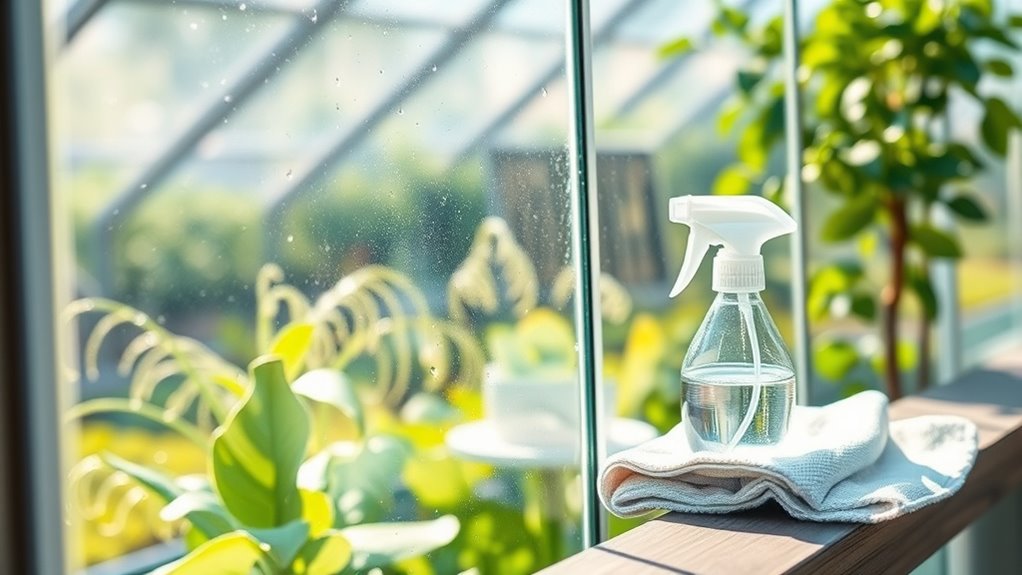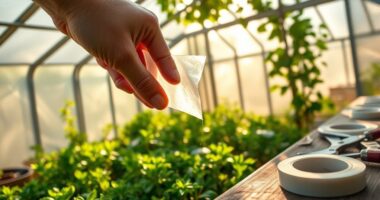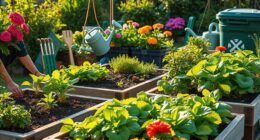To clean and sanitize greenhouse surfaces effectively, regularly remove debris from benches, tools, and floors, paying attention to crevices and hard-to-reach areas. Use brushes or cloths with soap and water to scrub away organic matter before applying disinfectants like diluted bleach or hydrogen peroxide. Make certain you follow product instructions for contact time and proper ventilation. Consistent surface maintenance reduces disease risks and promotes healthy plant growth—discover more tips to keep your greenhouse thriving.
Key Takeaways
- Develop a routine schedule for cleaning all greenhouse surfaces, including benches, tools, and floors, to prevent pathogen buildup.
- Remove visible debris and organic matter before disinfecting to ensure disinfectants work effectively.
- Use appropriate disinfectants like diluted bleach or hydrogen peroxide, following manufacturer instructions for contact time and safety.
- Scrub surfaces thoroughly with brushes or cloths to eliminate dirt and crevices where microbes can reside.
- Maintain proper ventilation during and after disinfection to dissipate fumes and ensure a safe environment.

Maintaining clean and sanitized surfaces in your greenhouse is indispensable for healthy plant growth and preventing disease. When you focus on effective surface maintenance, you create an environment where pathogens struggle to survive, reducing the risk of outbreaks that can devastate your crops. Pathogen control begins with a routine that targets all surfaces—benches, tools, containers, and even the floors—since these are common vectors for disease transmission. Regular cleaning removes dirt, plant debris, and organic matter that provide breeding grounds for microbes. Sanitizing then kills lingering pathogens that cleaning alone might miss, guaranteeing your greenhouse remains a healthy space for plants to thrive.
Regular cleaning and sanitizing of greenhouse surfaces prevent disease and promote healthy plant growth.
You should develop a consistent schedule for surface maintenance, ideally daily or after each use. Start by removing visible debris from all surfaces, paying close attention to crevices and hard-to-reach corners where dirt tends to accumulate. Use a stiff-bristled brush or cloth to scrub surfaces, especially those that come into contact with plants or soil. For tools and containers, wash with soap and water before applying disinfectants. This step is essential because organic matter can neutralize many disinfectants, rendering them ineffective. Once thoroughly cleaned, disinfect surfaces using an appropriate sanitizing solution. Common choices include diluted bleach (sodium hypochlorite), hydrogen peroxide, or commercial disinfectants designed for horticultural use. Follow the manufacturer’s instructions carefully, guaranteeing proper contact time to maximize pathogen control. Incorporating proper surface maintenance techniques can significantly reduce microbial presence and improve overall plant health.
It’s important to understand that surface maintenance isn’t a one-off task but an ongoing process. By consistently disinfecting, you prevent the buildup of harmful microbes that could cause diseases like damping-off, botrytis, or powdery mildew. Keep in mind that some disinfectants may damage certain surfaces or materials, so test on small areas first or choose products compatible with your greenhouse surfaces. Proper ventilation during and after sanitizing helps dissipate fumes and ensures safety.
Additionally, establishing a protocol for cleaning and sanitizing tools and equipment is essential. Always clean tools immediately after use to remove plant sap, soil, and organic matter, then disinfect before storing. This practice prevents cross-contamination between different plant batches or sections of your greenhouse. Remember, maintaining a clean environment isn’t just about aesthetics; it’s a proactive step towards disease prevention. By prioritizing surface maintenance and pathogen control, you set your greenhouse up for healthy, vigorous plants and a more successful growing season.
Frequently Asked Questions
How Often Should Greenhouse Surfaces Be Cleaned for Optimal Hygiene?
You should clean your greenhouse surfaces at least once a month for ideal hygiene. Incorporate seasonal cleaning to remove dirt and debris, especially after planting or harvesting. Regular cleaning prevents disease buildup and maintains surface protective coatings, which prolongs surface life. Additionally, inspect surfaces frequently and clean more often if you notice grime or contamination. Consistent upkeep ensures a healthy environment for your plants and reduces the risk of pests and pathogens.
What Eco-Friendly Cleaning Agents Are Safe for Greenhouse Surfaces?
You should use eco-friendly cleaning agents like biodegradable disinfectants and natural cleaning solutions to keep your greenhouse surfaces safe. These products are safe for plants, humans, and the environment, reducing chemical buildup. Choose plant-based soaps, vinegar solutions, or citrus-based cleaners that are biodegradable and non-toxic. Regularly using these guarantees a healthy, sustainable greenhouse, minimizing environmental impact while maintaining ideal hygiene for your plants and workspace.
Are There Specific Cleaning Techniques for Delicate Greenhouse Materials?
Yes, you should use gentle cleaning techniques for delicate materials in your greenhouse. Avoid abrasive tools and harsh chemicals that could damage surfaces like glass or plastic. Instead, opt for soft cloths or sponges and eco-friendly, mild cleaning agents. Carefully wipe or rinse these materials, ensuring no residue remains. Regular, gentle cleaning helps preserve your greenhouse’s delicate surfaces while maintaining a healthy environment for your plants.
How Can I Prevent Mold and Mildew Growth on Greenhouse Surfaces?
To prevent mold and mildew growth on greenhouse surfaces, you should apply mold-resistant coatings regularly and use natural antifungal treatments like neem oil or tea tree oil. Make certain good air circulation and control humidity levels, as damp conditions promote mold. Clean surfaces thoroughly before applying these treatments, and monitor the environment frequently to catch any early signs of mold. Consistent maintenance keeps your greenhouse healthy and mold-free.
What Are the Best Practices for Sanitizing Greenhouse Tools and Equipment?
Imagine your tools gleaming like new as you sanitize them. You should regularly perform tool sterilization by soaking tools in a disinfectant solution, ensuring all crevices are reached. Keep equipment maintenance consistent, checking for rust or damage, and clean after each use. Use a brush or cloth to scrub off dirt, then dry thoroughly. This routine keeps your tools effective, prevents disease spread, and maintains a healthy, productive greenhouse environment.
Conclusion
By consistently cleaning and sanitizing your greenhouse surfaces, you create a clean, healthy haven for your plants. This simple, steady routine reduces risks, repels pests, and promotes pristine, pest-free growth. Remember, maintaining meticulous methods matters more than many might realize — it’s about safeguarding your greenhouse’s glow. So, stay steadfast, scrub, sanitize, and sustain your space’s success, ensuring your green oasis continues to grow gorgeously with guaranteed growth and guaranteed gusto.








